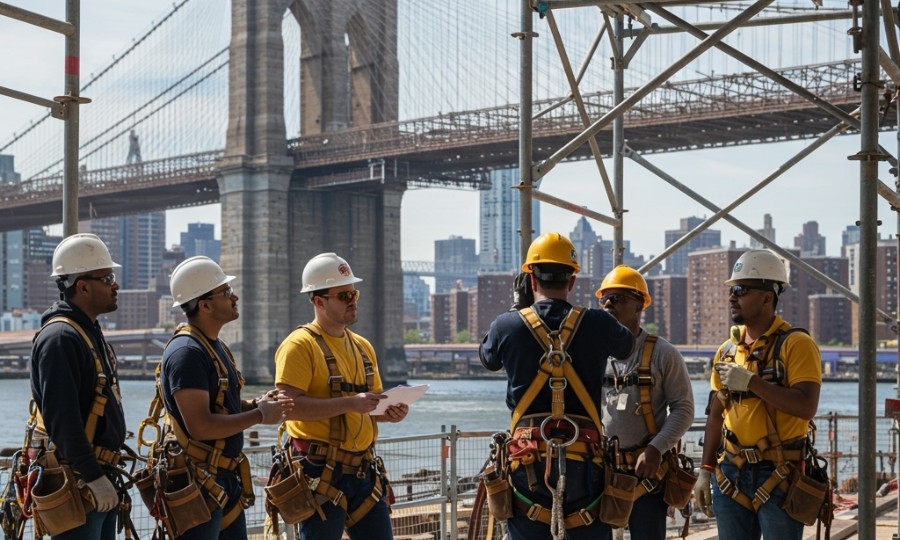
When you picture a bustling Brooklyn construction site, what comes to mind? Likely the impressive steel skeletons rising into the sky, the symphony of machinery, and the focused energy of skilled workers. But beneath that productive hum lies a silent, often devastating risk: falls from heights. It’s a sobering truth that these incidents remain the leading cause of fatalities and serious injuries in construction, especially when we’re talking about scaffolding, ladders, and roofs. Don’t you think it’s time we really dug into why this happens and, more importantly, how we can stop it?
For American workers, particularly those building our vibrant cities like New York, the stakes couldn’t be higher. We’re not just talking about minor bumps and bruises; we’re talking about life-altering injuries and, tragically, deaths. The Occupational Safety and Health Administration (OSHA) consistently highlights falls as one of its “Fatal Four” hazards, underscoring their severe impact. It’s not just a statistic; it’s someone’s father, mother, sibling, or friend whose life is irrevocably changed. That’s why understanding prevention, and your rights, is absolutely critical.
The High Stakes of Brooklyn’s Vertical Workspaces
Working at height is inherently risky, but it doesn’t have to be deadly. In Brooklyn, with its constant development and vertical expansion, workers are frequently on elevated platforms. Scaffolding, for instance, is a bedrock of urban construction, providing access to multiple levels. Yet, improper erection, inadequate planking, or a lack of guardrails can turn this essential tool into a deathtrap. Think about a scaffold that hasn’t been inspected in days, perhaps after a windy night. Would you feel safe climbing it? Probably not.
Ladders, too, seem simple enough, right? But they’re involved in countless falls. Often, it’s something as basic as using the wrong type of ladder for the job, placing it on an unstable surface, or overreaching instead of repositioning. We’ve all seen someone (maybe even ourselves) try to stretch that extra foot to avoid moving the ladder – it’s a common, dangerous shortcut. And then there are roofs, particularly sloped ones, where a momentary lapse in judgment or a lack of fall protection can lead to catastrophic consequences. Imagine a worker trying to secure a new section of roofing without proper harnesses or safety lines, perhaps rushing to beat an incoming storm. It’s a recipe for disaster.
Building a Fortress of Safety: Essential Prevention Strategies
Preventing falls isn’t rocket science, but it does require unwavering commitment from everyone involved, from site managers to individual workers. Here’s the thing: most falls are entirely preventable with the right strategies in place. First and foremost, comprehensive training is non-negotiable. Workers need to understand the hazards, know how to properly use and inspect equipment, and be aware of emergency procedures. This isn’t just a one-and-done session; it’s ongoing education, reinforced regularly.
Then there’s the equipment itself. Personal Fall Arrest Systems (PFAS) like harnesses, lanyards, and anchor points are lifesavers, but only if they’re used correctly and inspected before each use. Guardrails on scaffolds and elevated platforms aren’t just suggestions; they’re legal requirements and fundamental barriers against falls. Safety nets, while sometimes cumbersome, provide a crucial backup for areas where other fall protection isn’t feasible. For example, a major Brooklyn development project might implement a daily morning safety briefing where all workers review the day’s tasks, identify potential fall hazards, and confirm that all necessary fall protection equipment is in place and properly donned. This kind of proactive approach significantly reduces risks.
Regular site inspections are another cornerstone. A supervisor walking the site, checking scaffolding integrity, ladder placement, and the use of fall protection isn’t just fulfilling a duty; they’re potentially saving lives. It’s about creating a culture where safety isn’t just a rule, but a shared value. You might be thinking this won’t work because workers are always rushing, but a well-managed site prioritizes safety without compromising efficiency. In my experience, a safe site is often a more efficient site.
New York’s Shield: Understanding Labor Law 240
For workers in New York, there’s a powerful legal protection specifically designed to address gravity-related falls: New York Labor Law 240, often called the “Scaffold Law.” This isn’t just another regulation; it’s a critical piece of legislation that places absolute liability on owners and general contractors for providing adequate safety devices for workers at height. What does “absolute liability” mean? It means if a worker falls due to a lack of proper safety equipment or a failure of that equipment (like a ladder slipping, or a scaffold collapsing), the owner or contractor can be held liable, even if the worker contributed in some small way to the incident. It’s a robust protection, acknowledging the inherent dangers of elevated work and placing the burden of safety squarely on those in control of the worksite.
Let’s consider a scenario: a worker in Brooklyn is using an extension ladder to reach a second-story window frame. The ladder, provided by the contractor, doesn’t have proper non-slip feet and is placed on a slightly uneven surface. It slips, and the worker falls, sustaining serious injuries. Under Labor Law 240, the contractor or owner could be held responsible because they failed to provide a safe and appropriate ladder, or ensure it was used safely. This law is pivotal for ensuring that construction companies take fall prevention seriously, knowing they’ll be held accountable if they don’t.
Your Next Steps: After an Incident and Beyond
We know this feels overwhelming, especially when you’re trying to wrap your head around complex laws and safety protocols. But if a fall from height does occur, whether to you or a colleague, knowing the immediate steps is crucial. First, ensure immediate medical attention for the injured party. Their well-being is paramount. Second, report the incident immediately to a supervisor and document everything you can: photos of the scene, details of the equipment, witness statements, and the time and date. This documentation can be invaluable later on.
You might be thinking this won’t work because the company will try to cover it up, but clear, timely reporting and documentation are your best defense. Finally, it’s always wise to understand your legal options. Consulting with an attorney specializing in New York construction accidents can help you navigate the complexities of Labor Law 240 and ensure your rights are protected. They can explain how the law applies to your specific situation and guide you through the process, providing a much-needed sense of relief during a stressful time.
Ultimately, preventing falls from heights on Brooklyn job sites requires a collective effort. It demands vigilance, proper training, correct equipment, and a deep respect for the lives of those who build our city. By prioritizing safety and understanding the protections afforded by laws like Labor Law 240, we can work towards a future where every worker returns home safely at the end of their shift. Isn’t that what we all want?
Free Case Consultation
Injured in an accident? Contact Rosenberg, Minc, Falkoff & Wolff for a free and confidential case review with an experienced NYC personal injury attorney.


